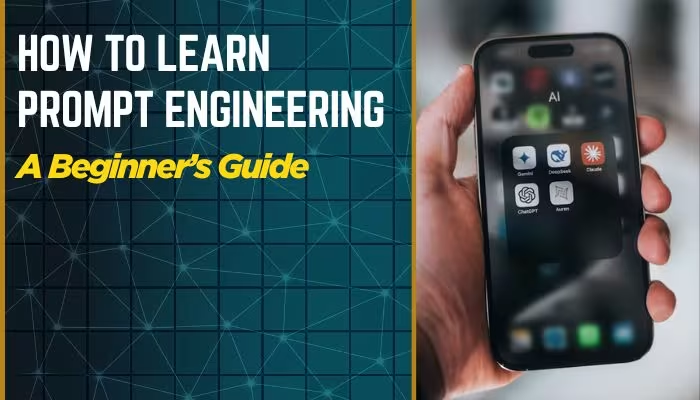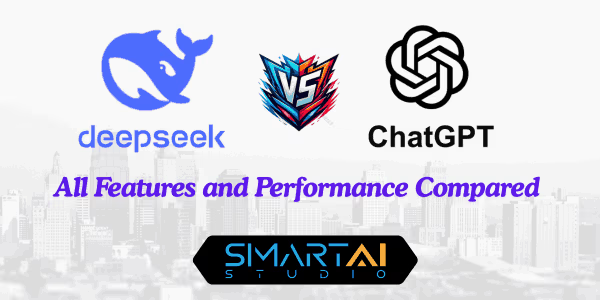Ever typed a prompt in a popular AI chatbot like ChatGPT or Gemini? But you got a vague or disappointing answer. Right? The problem isn’t the AI; it’s the prompt.
The prompting with AI chatbots is not only a skill but has evolved into a competent skill in almost all industries. The skill is called ‘Prompt Engineering’. A person with the knowledge of it is a ‘Prompt Engineer’.
While once a specialized technical concept, it is now a core competency for students and professionals looking to stay ahead in an AI-driven world. The demand for skilled “prompt engineers” is growing rapidly.
This isn’t just a fleeting trend; it’s a career upgrade that can future-proof your skills in nearly every industry. In this comprehensive guide, we will break down the art of communicating with AI. It will show you the foundational skills you need, and provide a clear, step-by-step roadmap to becoming a proficient prompt engineer.
What Is A Prompt Engineer? Why Is It A Career Upgrade?
At its most basic level, a prompt engineer is a person who is an expert at writing instructions for AI models to get a desired output. Think of it as being a translator between human intent and artificial intelligence. The person who can ask the right questions gets the best answers. This skill goes far beyond simply typing a query into a search bar. It involves understanding the AI’s capabilities and limitations, structuring your prompts in a specific way, and iterating on them until you get the perfect response.
Why is this so valuable? Because as AI tools become more integrated into our daily workflows, the people who can use them efficiently will be the most valuable. A professional who can leverage AI to automate tasks, generate content, or analyze data in minutes will be far more productive than someone who can’t. Prompt engineering isn’t just about a new job title; it’s about a new way of working that makes you unstoppable. It’s the ultimate career upgrade.
History of Prompt Engineering
Science and technology are evolving at a similar speed to your bike. The world is changing rapidly with the advent of AI. The concept of guiding AI with text has existed for decades, dating back to early conversational programs like ELIZA in the 1960s. These systems relied on rigid, rule-based instructions. The field of natural language processing (NLP) evolved through statistical models and neural networks, but the user-driven “prompting” we know today didn’t emerge until the advent of large language models (LLMs).
The major turning point was the release of GPT-3 in 2020. Its ability to perform a wide variety of tasks with simple natural language inputs demonstrated the power of “in-context learning.” This sparked the discipline of prompt engineering, transforming it from a technical input to a crucial creative skill for anyone interacting with powerful AI.
Real-World Examples for Professionals and Students
- For the Project Manager: Instead of spending hours drafting a project plan, you could use a single, well-crafted prompt to generate an initial draft, complete with timelines, resource allocation, and potential risks.
- For the College Student: Imagine needing to write a research paper. A student could use prompt engineering to quickly summarize a dozen academic articles. Use it to brainstorm essay topics or even generate practice questions for an upcoming exam.
- For the Software Developer: Even with coding skills, a developer can use a prompt to generate boilerplate code or debug a complex function. It can even explain a piece of code written by a colleague. It’s about working smarter, not harder.
Foundational Skills: The Mindset of a Prompt Engineer
While prompt engineering might sound technical, the most important skills you need are not related to coding. The best prompt engineers are often great communicators, problem-solvers, and critical thinkers. Developing a strong “prompting mindset” is the first and most crucial step in your learning journey.
The Core Principles of Effective Prompting
To succeed, you must embrace three core principles that will guide every prompt you write.
- Clarity: Be specific. Vague instructions lead to generic results. Instead of writing short prompts like “write about a blog,” specify “write a 500-word blog post on the benefits of exercise for mental health, formatted for a professional audience and using subheadings.” The more detail you provide, the better the output.
- Context: Provide all the necessary background information. An AI doesn’t have a personal history or a deep understanding of your business. Give it the context it needs to deliver a relevant response. For example, tell it to “act as a senior marketing manager in a highly reputed branding firm” or “use data from the following report.”
- Constraints: Set clear boundaries and limitations. Tell the AI what you don’t want, what length the output should be, and what tone it should use. This helps prevent irrelevant or undesirable information and keeps the AI focused on your goals.
Mastering these three C’s is the foundation of effective prompt engineering and will set you up for success.
The Prompt Engineering Roadmap: A Step-by-Step Guide
Ready to get started? This step-by-step roadmap is designed for students and professionals with no prior experience. Follow these steps to build your skills from the ground up.
Step 1: Master the Basics
Start by experimenting with widely available models like ChatGPT, Google’s Gemini, or Claude. Your goal here is to simply get comfortable with the interface and the concept of conversational AI. Use it for everyday tasks, like drafting an email, generating unreal dreamy images, or brainstorming ideas. This hands-on practice is essential for building an intuitive feel for how these models respond. Don’t worry about perfect prompts at this stage; just focus on understanding the interaction.
Step 2: Learn Key Techniques
Once you’re comfortable with the basics, it’s time to learn the core techniques that differentiate a good prompt from a great one. These are the tools of the trade that the experts use.
- Zero-Shot Prompting: The simplest method, where you ask a question and get an answer without providing any examples. (e.g., “What is the capital of France?”).
- Few-Shot Prompting: This involves providing one or more examples in your prompt to teach the AI the pattern you want it to follow. (e.g., “Example 1: Input: [text], Output: [summary]. Now, summarize the following text: [new text]”).
- Chain-of-Thought Prompting: A powerful advanced technique where you ask the AI to “think step-by-step.” This forces the model to show its reasoning process, leading to more accurate and reliable outputs, especially for complex tasks.
Step 3: Practice with Real-World Examples
To truly master prompt engineering, you need to move beyond theory and apply your skills to practical tasks. The best way to learn is by using AI to solve problems directly related to your profession or field of study. Here’s how different individuals can put their new skills into practice.
- For the Marketing Professional: Use prompting to create A/B test variations for headlines, generate a week’s worth of social media post ideas, or draft an entire content calendar.
- For the Project Manager: Use AI to draft a project plan based on a simple brief, generate meeting agendas, or summarize long threads of email communication to quickly catch up on a project’s status.
- For the College Student: Use your prompting skills to create study guides from lecture notes, summarize dense academic papers, or generate practice questions to help you prepare for an upcoming exam.
- For the Human Resources Professional: Use a detailed prompt to create an effective job description that attracts top talent. Even drafting an engaging employee welcome email series is a great idea. Summarize key insights from employee feedback surveys.
- For the Financial Analyst or Consultant: Use AI to generate a high-level summary of a complex financial report, create presentation talking points, or even simulate different business scenarios based on provided data.
- For the Healthcare Professional: Use prompts to quickly summarize complex patient notes for a colleague, draft a clear and empathetic email to a patient about their follow-up care, or generate a simple, jargon-free handout to explain a procedure.
- For the Freelancer or Small Business Owner: Use prompting to brainstorm ideas for new services, draft a compelling business proposal, or write sales copy for a new product, saving you valuable time and money.
Step 4: Build a Portfolio
Once you have become an expert with prompting skills, create a portfolio of your best prompts and their outputs. This can be a simple PDF document or a section on your personal website. A portfolio is essential for showcasing your expertise to potential employers or clients. Include a few before-and-after examples that demonstrate how a basic prompt was refined into a highly effective one, showing your growth and skill in the process.
Related Topics Trending on Social Media
✅ Nano Banana AI Prompts for 3D Figurines
✅ Prompts for Google Gemini AI Saree Photos
Essential Tools & Resources for Your Learning Journey
While your most important tool is your own mind, these resources can accelerate your learning. The community around prompt engineering is incredibly active, and the number of high-quality resources available online is immense. There are tons of free courses, quick tutorials, and in-depth guides. These are sufficient to make you a prompt engineering expert. From a structured learning timeline to various tutorial types and other considerations for learners, you will find a resource for every learning style and goal.
Best Websites To Learn And Master Prompt Engineering
Free Online Courses & Tutorials
You don’t need to spend a fortune to get started. Many high-quality, free resources are available:
- Coursera: Look for introductory courses on Prompt Engineering from reputable universities. These often provide structured lessons and clear learning objectives.
- YouTube: Many AI experts and channels offer free, in-depth tutorials and workshops on prompting techniques.
- Prompting Guides: Websites like PromptingGuide.ai and LearnPrompting.org offer comprehensive, free documentation on various prompting methods and strategies.
- Microsoft Learn: Microsoft’s official learning hub offers free, modular courses on prompt engineering, often tailored for their specific tools like Azure OpenAI Service and GitHub Copilot.
Books and Guides
For a more structured and long-term learning approach, consider a book or a comprehensive digital guide. These resources often provide case studies and a deeper dive into the technical and ethical aspects of prompt engineering.
10 Best Websites & Resources to Master Prompt Engineering
1. Coursera
These platforms are perfect for those who want a structured, academic-style curriculum. Courses are often created by top universities like Vanderbilt and major tech companies like IBM. They offer hands-on projects and often include professional certificates to showcase your new skills.
Top 3 Coursera Courses for Prompt Engineering
- Prompt Engineering Specialization
- Generative AI: Prompt Engineering Basics
- Large Multimodal Model Prompting with Gemini
2. PromptingGuide.ai
This is a go-to, free, and open-source guide for everything about prompt engineering. It’s a textbook-style resource that goes from foundational concepts to advanced techniques. It’s a must-read for anyone who wants to understand the science behind effective prompting.
3. Official AI Developer Guides (OpenAI, Google, Anthropic)
For the most accurate and up-to-date information, there is no substitute for the official guides. They provide best practices directly from the creators of the models and offer insights into the specific nuances of each AI.
- OpenAI’s Prompt Engineering Guide: Offers clear best practices for GPT models.
- Google’s Prompting Essentials: Focuses on strategies for their Gemini models.
- Anthropic’s Prompt Engineering Guide: Provides a high-level overview with a focus on their Claude models.
4. Udemy
Udemy is an excellent resource for affordable, project-based courses. Its vast library includes everything from beginner-friendly introductions to highly specialized courses on using AI for marketing, content creation, and more.
5. DeepLearning.AI
Founded by AI pioneer Andrew Ng, this platform offers a series of short, high-quality, and often free courses. Their “Prompt Engineering for Developers” course is particularly popular and a fantastic, quick way to gain practical skills with the OpenAI API.
6. LearnPrompting.org
This website is a comprehensive, hands-on learning hub. It offers a variety of free courses, a community forum, and even an interactive AI playground. It’s a great resource for all skill levels, from those just starting to advanced users looking to refine their techniques.
7. Hugging Face
Known as the “GitHub for machine learning,” Hugging Face is an essential platform for developers and enthusiasts. While more technical, their blog posts and tutorials are a goldmine for learning about the latest AI models and advanced prompting techniques.
8. Kaggle
Primarily for data scientists, Kaggle hosts a variety of datasets, notebooks, and competitions. Many of these resources include practical tutorials on how to use AI models and prompt engineering for data analysis, offering a unique and highly applicable learning path.
9. Medium & Towards Data Science
These platforms are home to a huge number of articles written by AI experts and practitioners. You can find everything from quick tips to in-depth case studies and tutorials. They are a great way to stay up-to-date with new trends and discover innovative approaches.
10. Prompt Marketplaces (e.g., PromptBase, PromptHero)
For a more hands-on, “learning by example” approach, exploring prompt marketplaces can be incredibly useful. These sites allow you to see, buy, and sell well-crafted prompts. Studying successful prompts here can give you a tangible understanding of what works and what doesn’t.
10 Most Popular Prompt Engineering Courses
- Prompt Engineering Specialization by Vanderbilt University
- ChatGPT Prompt Engineering for Developers
- Generative AI: Prompt Engineering Basics by IBM
- Prompt Engineering for Everyone Bootcamp
- Prompt Engineering with Llama 2 & 3
- Prompt Engineering for Microsoft 365 Copilot
- Complete ChatGPT Prompt Engineering Course
- Prompt Engineering Zero To Hero
- AI Prompt Engineering Fundamentals
- Large Multimodal Model Prompting with Gemini
Common Mistakes to Avoid Using AI Tools
As you begin your journey, be aware of these common pitfalls. Avoiding them will save you a lot of time and frustration.
- Being Too Vague: The most frequent mistake is not providing enough detail. If you ask for a “summary,” the AI will give you a generic one. If you ask for a “summary in bullet points for an executive audience, highlighting key financial takeaways,” you’ll get a much more useful response.
- Not Iterating: Never assume your first prompt is the best. The real power of prompt engineering comes from testing different versions and refining your instructions. If the first output isn’t right, rephrase your prompt and try again.
- Ignoring the AI’s Limitations: Remember that AI can hallucinate, or make up facts. Always fact-check any critical information, especially if it’s for a professional or academic purpose. Acknowledging these limitations will make you a more responsible and effective prompt engineer.
The Future of Prompt Engineering and Your Career
Prompt engineering is not just a trend; it’s a fundamental shift in how we interact with technology. As AI models become more powerful, the ability to communicate with them effectively will become an essential skill in virtually every job. The role of the prompt engineer may evolve, but the core skills, critical thinking, clarity, and creativity, will remain highly valuable. For students and professionals, learning prompt engineering is an investment in your long-term career growth, making you a more efficient, innovative, and indispensable professional in the age of AI.
Conclusion
Learning how to learn prompt engineering is one of the most valuable skills you can acquire today. It’s a key to unlocking new career opportunities and staying relevant in a world increasingly powered by artificial intelligence. By mastering the core principles of clarity, context, and constraints, you can move from simply using AI to truly leveraging its power. The resources are readily available, the learning curve is approachable, and the career benefits are immense. Start your journey today by experimenting with simple prompts, and watch as this new skill transforms your professional capabilities. If you found this guide helpful, be sure to explore more of our content to stay ahead of the curve in the world of AI and digital marketing.
FAQ About Prompt Engineering
No, you do not. While a basic understanding of programming can be helpful for certain tasks, the core skills of a prompt engineer are focused on language, logic, and problem-solving, not writing code. A basic knowledge of coding can save you a lot of time when using AI tools.
You can learn the basics in just a few days of dedicated practice. However, mastering advanced techniques and becoming a true expert is a continuous process of learning and experimentation.
While the title itself may evolve as AI technology changes, the core skills of effective communication with AI will remain a valuable and transferable asset for the foreseeable future.
Salaries for prompt engineers can vary widely based on location and experience. They also have high earning potential. According to the research of sites like Glassdoor and ZipRecruiter, in the United States, the average base salary often falls between $80,000 and $130,000. The top-tier professionals at major tech companies earn even more than $200,000. In India, salaries for skilled prompt engineers can range from ₹15 to ₹35 lakhs per annum, with experienced professionals in top firms commanding even higher pay.
While prompt engineering as a specific job title is relatively new, the underlying skills are durable and have a strong future. The role is likely to evolve as AI models become more intuitive, but the core competencies remain. Professionals who master these skills can transition into related roles such as AI trainers, AI product managers, or specialized AI consultants, ensuring a robust and future-proof career.






